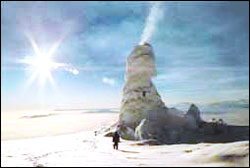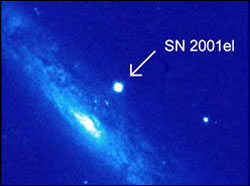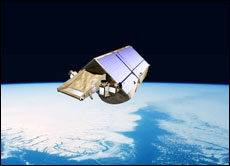This area deals with the fundamental laws and building blocks of nature and how they interact, the properties and the behavior of matter, and research into space and time and their structures.
innovations-report provides in-depth reports and articles on subjects such as astrophysics, laser technologies, nuclear, quantum, particle and solid-state physics, nanotechnologies, planetary research and findings (Mars, Venus) and developments related to the Hubble Telescope.

Nanotechnologists could have a firmer handle on the forces at play in their microscopic world thanks to recent physics research at Purdue University.
The latest in a series of experiments aimed at revealing fundamental knowledge of the universe has yielded precise measurement of the so-called Casimir force – a force that could make tiny machines behave erratically, causing a thorn in the side of nanotechnology manufacturers. A team, including Purdue physicist Ephraim Fischbach, has answered

The universe is gently fading into darkness according to three astronomers who have looked at 40,000 galaxies in the neighbourhood of the Milky Way. Research student Ben Panter and Professor Alan Heavens from Edinburgh University´s Institute for Astronomy, and Professor Raul Jimenez of University of Pennsylvania, USA, decoded the “fossil record” concealed in the starlight from the galaxies to build up a detailed account of how many young, recently-formed stars there were at different periods in the 1

Giant hollow towers of ice formed by steaming volcanic vents on Ross Island, Antarctica are providing clues about where to hunt for life on Mars.
University of Melbourne geologist, Dr Nick Hoffman has found evidence from recent infra-red images of Mars that similar structures may exist on Mars and, if life is to be found, such towers may be best place to start looking.
Hoffman has drawn attention to strange temperature anomalies in these latest Mars images taken with an inf

First Polarimetric Detection of Explosion Asymmetry has Cosmological Implications
An international team of astronomers [2] has performed new and very detailed observations of a supernova in a distant galaxy with the ESO Very Large Telescope (VLT) at the Paranal Observatory (Chile). They show for the first time that a particular type of supernova, caused by the explosion of a “white dwarf”, a dense star with a mass around that of the Sun, is asymmetric during the initial phases of exp

Classification of quantum phenomena critical to high-temp superconductivity
A team of physicists led by researchers at Rice University has developed the first thermodynamic method for systematically classifying quantum phase transitions, mysterious electromagnetic transformations that are widely believed to play a critical role in high-temperature superconductivity.
The new research is described in two papers – one theoretical and one experimental – in the Aug. 8 issue of Phy

CryoSat, the first Earth Explorer mission within ESA’s Living Planet Programme, is now entering the final phase of assembly prior to its scheduled launch next year.
CryoSat is designed to measure changes in the Earth’s terrestrial and marine ice fields and aims to provide conclusive evidence as to whether there is a trend towards diminishing polar ice cover as a result of climate change.
The first part of the Critical Design Review (CDR), which was successfully completed on